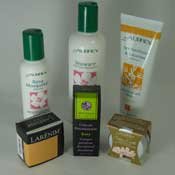It was a muggy Saturday night, and the light rain against the windowpane made me drowsy. I leaned back on my leather couch and kicked my feet up to watch TV. Flipping through channels, I noticed an abundance of anti-acne product commercials.
With products dancing across the screen, and celebrities boasting about them, I wondered: Why do people develop so much skin irritation in the first place?
Many of our skin-care products are part of the problem. American women use 20 or more beauty products every day. Men use fewer, about six. The majority of those products are not tested for safety, and many of their ingredients are outright harmful, causing everything from minor irritation to cancer—that's right, your "beauty" product may contain carcinogens. And because the U.S. Food and Drug Administration does not regulate personal-care products, manufacturers can use words like "natural" or "organic" indiscriminately—and many do. Companies don't even have to put some ingredients on labels.
When it comes to buying personal-care items, it's strictly buyer beware. If you're one of the many women who wear makeup every day, over a year, you could absorb more than five pounds of chemicals.
"Putting chemicals on your skin is actually far worse than ingesting them," Dr. Joseph Mercola says on his natural-health website, mercola.com. "When you eat something, the enzymes in your saliva and stomach help break it down and flush it out of your body. When you put these chemicals on your skin, however, it is absorbed straight into your blood stream without filtering of any kind. "
In "Planet Home" (Clarkson Potter, 2010, $19.99), Jeffrey Hollender, co-founder of Seventh Generation green products, emphasizes that what goes on our skin goes into our bodies, and uses nicotine patches as an example.
"The beauty and personal-hygiene products we use on a daily basis are filled with a host of questionable chemicals: hormone disrupters; skin, eye, and lung irritants; reproductive toxicants; and carcinogens (actual, probable and possible)," he writes.
Research backs him up: The Environmental Working Group, a non-profit group that works to protect public health and the environment, rates thousands of products on its searchable Skin Deep database (ewg.org/skindeep).
"Some companies use ingredients that may cause cancer or that are associated with developmental problems," EWG states on its website. "Many cosmetics' ingredients penetrate the skin. People ingest those used on lips and hands and inhale sprays and powders. When risky and unstudied chemicals are used in cosmetics, the stakes are high."
The good news is that you can make better choices for your skin. "There are safe—or at least safer—versions of just about every lotion, elixir and treatment on the market," Hollender writes. "
Buy Safe Cosmetics
Dr. Joseph Mercola, an Illinois-based osteopath and internal-medicine physician, offers these tips:
• Look for the genuine USDA Organic Seal.
• If you can't pronounce it, you probably don't want to put it on your body. Ask yourself, "Would I eat this?"
• Look for fragrance-free products. One artificial fragrance can contain thousands of chemicals.Fragrances are a major cause of allergic reactions.
• Pay attention to the order of ingredients. Manufacturers are required to list ingredients in descending order by volume.
• Stick to the basics. Do you really need 20 products to prepare for your day?
• Buy products that come in glass bottles rather than plastic. Chemicals can leach out of plastics and into the contents.
• Look for products made by companies that are earth-friendly, animal-friendly and green.
SOURCE: "The Ominous Truth Behind Cosmetic Beauty Claims," by Dr. Joseph Mercola, mercola.com.
Read the Label
The Campaign for Safe Cosmetics, a coalition of advocates, cosmetic companies, retailers and others aiming for safer products, lists these nine top ingredients as "chemicals of concern" due to research suggesting their "connections to long-term health concerns like cancer and reproductive problems." A number of countries have restricted or banned many of them.
• Triclosan: found in antibacterial soaps and detergents, many deodorants, toothpastes, cosmetics, fabrics and plastics.
• Synthetic Musks: found in many perfumes, lotions, colognes and body sprays.
• Formaldehyde: found in nail polishes, nail glues, eyelash glues, hair gels and hair-smoothing products. Baby shampoo, baby soap and body washes may contain formaldehyde even though it is not listed as an ingredient.
• Nitrosamines: an impurity found in nearly every kind of personal care product, including mascara, concealer, conditioner, baby shampoo, pain relief salve and sunless tanning lotion.
• Lead and Other Heavy Metals: found in sunscreens, foundation, nail colors, lipsticks and whitening toothpaste.
• Parabens: found in shampoos, conditioners, lotions, and facial and shower cleansers
and scrubs.
• Phthalates: added to fragrances; common "because fragrance occurs in nearly every conceivable product, including lotions, soaps, cleansers and hair-care products."
• Hydroquinone: one of the most toxic ingredients still used in cosmetics, and commonly found in skin lighteners.
• 1,4-dioxane: a manufacturing-produced contaminant; found in products that create suds, such as shampoo, liquid soap and bubble bath.
Find companies that have signed the Compact for Safe Cosmetics and read more about harmful chemicals in beauty products at http://www.safecosmetics.org.



Comments
Use the comment form below to begin a discussion about this content.